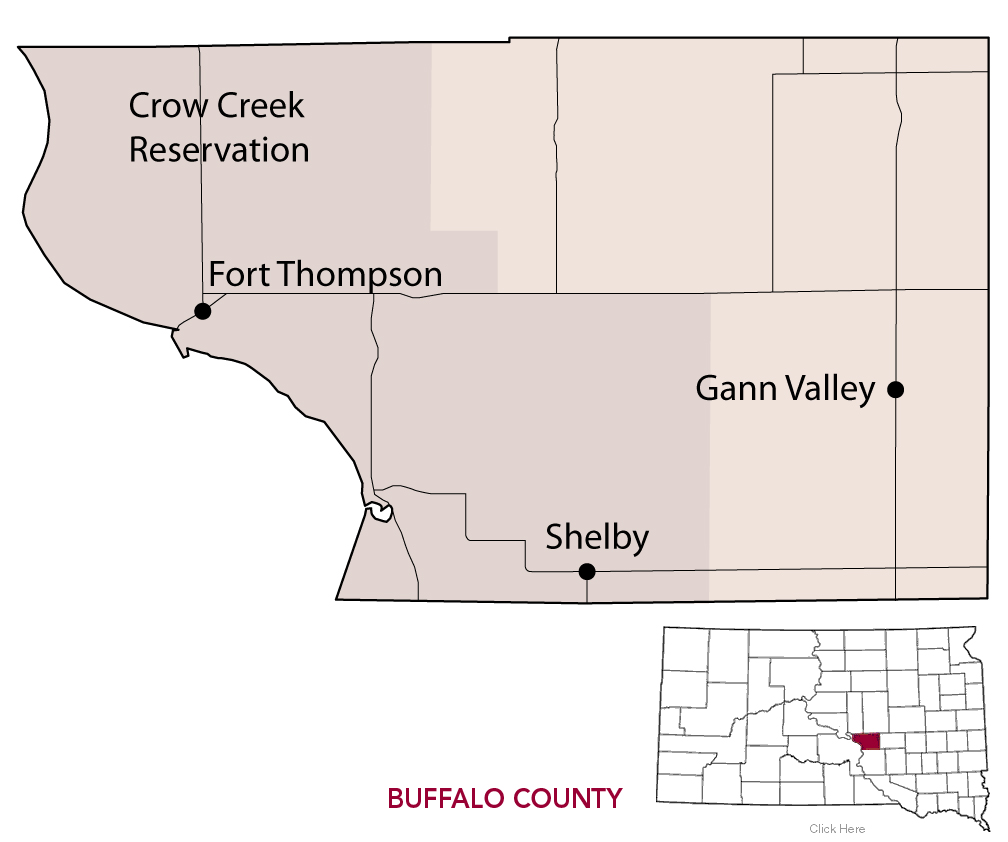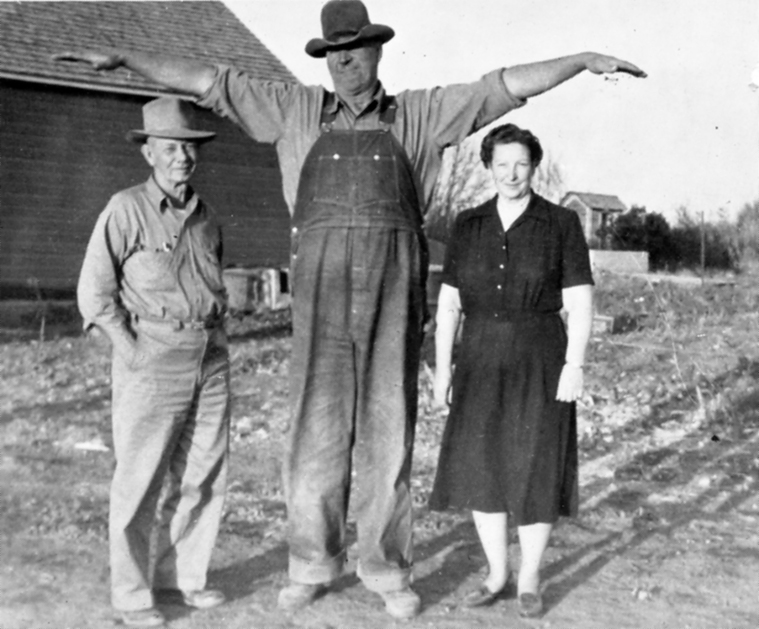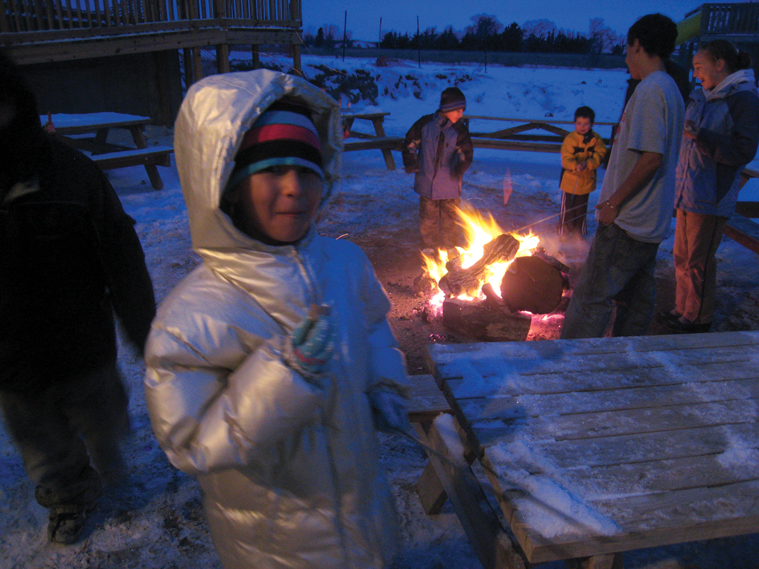The Gift of South Dakota
Subscriptions to South Dakota Magazine make great gifts!
Subscribe today — 1 year (6 issues) is just $29!
County of Extremes
Feb 23, 2016
 |
Buffalo County is the answer to a lot of South Dakota trivia questions: Where is the nation’s smallest county seat? Where did South Dakota’s tallest sheriff serve? Where was the highest temperature ever recorded in the state? But none of that is to say that Buffalo County is trivial. That’s because its the home of the Crow Creek Indian Reservation, and has been a settlement site for North American tribes for centuries. The dynamic between those ancient tribes and, more recently, between Natives and non-Natives in this county along the Missouri River, have led to tragedies and sadness that can’t be ignored, but hopefully South Dakotans a better understanding of life in this culturally diverse state.
First, the light-hearted facts about Buffalo County, which was established in 1873 and named for the enormous herds of American bison that roamed the prairies. With a population of just 14, Gann Valley is indeed the smallest county seat in the nation. Several years ago, when we wrote a story about places to visit in every county, we directed readers to the Gann Valley courthouse, where Elaine Wulff was serving as Buffalo County’s register of deeds and auditor. The names of wartime soldiers are painted in calligraphy on huge signs inside the courthouse. The dead are remembered in red. There are no restaurants in Gann Valley, but locals gather for mid-morning coffee at the community center.
Gann Valley was also home to August Klindt, who at 7-feet, 3-inches was the tallest man ever to serve as a county sheriff in South Dakota (we’re not sure if that is an actual statistical record, but we feel pretty good about making the claim). Klindt was sheriff for six years in the 1940s and made a lasting impression on those who caught a glimpse of him.
 |
| August Klindt, also known as the Gann Valley Giant, stood 7 feet, 3 inches tall. He is pictured with a man and woman each said to have been nearly 6 feet tall. |
Retired Brookings newspaperman Chuck Cecil was a boy growing up in Wessington Springs in the 1940s. He recalled seeing the “Gann Valley Giant” on Saturday night in downtown Springs. “We were all packed into the parked Model A with Mom, waiting for Dad to complete his Saturday ritual in the saloon just down the street … and here comes the Gann Valley Giant, cutting a wide swath through the crowd. He was a good egg crate taller than anyone else on the street — like a stalk of rogue corn in a lush Dakota field. He wore the biggest bib overalls you ever saw. The legs had been elongated with extra material that didn’t match, and the suspenders had been over-suspended and were over-taxed.”
The museum in Wessington Springs has a collection of Klindt’s belongings, including his big felt hat and a ring. The curator claims a 50-cent piece fits inside.
Finally, the highest temperature ever recorded in South Dakota came from Gann Valley, where the mercury reached 120 degrees on July 5, 1936. The record came in the midst of a sweltering heat wave that pushed temperatures above 100 degrees across much of the country. In July of 2006, a cattle rancher near Usta, northwest of Faith, who also supplies readings to the National Weather Service, reported 120 degrees, tying the long-held Gann Valley record.
 |
| A passing photographer found a group of kids playing basketball at a home along Highway 50. |
But Buffalo County has also been the source of serious study. In the late 1970s and early 1980s, archaeologists from the University of South Dakota examined a site along the banks of the Missouri River where centuries earlier hundreds of Native people were massacred. The Crow Creek Site is a National Historic Landmark and is still studied in an attempt to learn more about the lives and movements of early American tribes.
The investigative team discovered the remains of 486 people buried beneath a thin layer of river bottom clay. Evidence suggests the group was vastly outnumbered and that their attackers inflicted particular vengeance. Bodies were scalped, decapitated and dismembered. The massacre is believed to have occurred sometime around the year 1325, and while no definite cause has been determined, it was likely due to tribes competing for available land.
Today that land is home to the Crow Creek Indian Reservation, where the strained relations between Natives and non-Natives were discussed in one of the most talked-about stories to ever appear in South Dakota Magazine. Ray Deloria and Alfred St. John were star basketball players attending high school at Fort Thompson. When the school closed in 1954, they moved to Gann Valley, where they played for coach Quentin C. Miles. The introduction of two Native players caused a rift among the largely non-Native Gann Valley Buffaloes basketball team and their coach.
Gann Valley won its first game 68-53 over Pukwana, with Deloria doing most of the scoring. After the game, player Marvin Speck handed in his uniform. “If this is the way it’s going to be, I quit,” he said.
 |
| Crow Creek youth bundle up for the annual cold weather cookout, part of a celebration that concludes the Christmas season. |
Because Deloria stayed with the Miles family during the week, others in the community accused the coach of untoward behavior. He received a note one day from the father of one of his players. “I know you get paid to have them living with you,” the note said. “I wouldn’t be surprised if you had a girlfriend out on the reservation somewhere.”
The Buffaloes had talent and advanced to the state tournament. Unfortunately they lost in the first round, and for Deloria the story went downhill from there. He quit school and later joined the Army. He showed up sporadically at the Miles house asking for money until one day, Miles refused. “You never were much of a coach anyway,” Deloria said before shuffling away.
It’s no secret that Indian reservations are among the most impoverished places in America. Buffalo County ranks as the fifth poorest in South Dakota. But the Crow Creek tribe chooses to focus on positivity, especially in early January when they Little Christmas, one of the most unique holiday celebrations in the state.
The Lode Star Casino in Fort Thompson buys toys and clothes for children. St. Joseph Catholic Church provides meat for a Christmas potluck at the church hall, and the local Senior Center hosts a Christmas week banquet.
Maybe the most unusual component is a cold weather cookout. Children stage an outdoor program, no matter the temperature, followed by a hot dog and marshmallow roast. It could even be the answer to another Buffalo County trivia question.
Editor’s Note: This is the 20th installment in an ongoing series featuring South Dakota’s 66 counties. Click here for previous articles.









Comments